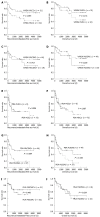Differential mucin phenotypes and their significance in a variation of colorectal carcinoma
- PMID: 23840140
- PMCID: PMC3703182
- DOI: 10.3748/wjg.v19.i25.3957
Differential mucin phenotypes and their significance in a variation of colorectal carcinoma
Abstract
Aim: To investigate mucin expression profiles in colorectal carcinoma (CRC) histological subtypes with regard to clinicopathologic variables and prognosis.
Methods: Mucin (MUC)2 and MUC5AC expressions were assessed by immunohistochemistry for a total of 250 CRC cases that underwent surgical resection. CRCs included 63 well-to-moderately differentiated adenocarcinomas (WMDAs), 91 poorly differentiated adenocarcinomas (PDAs), 81 mucinous adenocarcinoma (MUAs), and 15 signet-ring cell carcinomas (SRCCs). MUC2 and MUC5AC were scored as positive when ≥ 25% and ≥ 1% of cancer cells were stained positive, respectively. The human mutL homolog 1 and human mutS homolog 2 expressions were assessed by immunohistochemistry in PDAs to investigate mismatch-repair (MMR) status. Tumors that did not express either of these two were considered MMR-deficient. Results were analyzed for associations with clinicopathologic variables and the prognosis in individual histological CRC subtypes.
Results: MUC2-positive and MUC5AC-positive WMDA percentages were 49.2% and 30.2%, respectively. In contrast, MUC2-positive and MUC5AC-positive PDA percentages were 9.5% and 51.6%, respectively. MUC2 levels tended to decrease and MUC5AC levels tended to increase from WMDA to PDA. In 21 tumors comprising both adenoma and adenocarcinoma components in a single tumor (4 WMDAs, 7 PDAs, and 10 MUAs), MUC2 was significantly downregulated in PDA and MUC5AC was downregulated in PDA and MUA in the adenoma-carcinoma sequence. These results suggested that MUC2 levels might be associated with malignant potential and that MUC5AC expression was an early event in tumorigenesis. Despite worse prognoses than WMDA, high MUC2 expression levels were maintained in MUA (95.1%) and SRCC (71.5%), which suggested a pathogenesis for these subtypes distinct from that of WMDA. No significant associations were found between MUC2 expression and any clinicopathologic variables in any histological subtype. MUC5AC expression in PDA was closely associated with right-sided location (P = 0.017), absence of nodal metastasis (P = 0.010), low tumor node metastasis stage (P = 0.010), and MMR deficiency (P = 0.003). MUC2 expression in WMDA was a marginal prognostic factor for recurrence/metastasis-free survival (RFS) by univariate Cox analysis (P = 0.077) but not by multivariate Cox analysis (P = 0.161). MUC5AC expression in PDA was a significant prognostic factor for RFS by univariate Cox analysis (P = 0.007) but not by multivariate Cox analysis (P = 0.104). Kaplan-Meier curves and log-rank tests revealed that MUC2 expression was marginally associated with a better WMDA prognosis [P = 0.064 for RFS and P = 0.172 for overall survival (OS)] but not for PDA. In contrast, MUC5AC expression was significantly and marginally associated with a better PDA prognosis in terms of RFS and OS, respectively (P = 0.004 for RFS and P = 0.100 for OS), but not for WMDA and MUA.
Conclusion: Mucin core protein expression profiles and clinical significance differ according to histological CRC subtypes. This may reflect different pathogeneses for these tumors.
Keywords: Adenoma-carcinoma sequence; Colorectal carcinoma; Microsatellite instability; Mismatch repair; Mucin 2; Mucin 5AC; Pathogenesis; Poorly differentiated adenocarcinoma; Prognosis.
Figures




Similar articles
-
Aberrant cytokeratin expression as a possible prognostic predictor in poorly differentiated colorectal carcinoma.J Gastroenterol Hepatol. 2013 Dec;28(12):1815-22. doi: 10.1111/jgh.12319. J Gastroenterol Hepatol. 2013. PMID: 23808938
-
An immunohistochemical study of primary signet-ring cell carcinoma of the stomach and colorectum: II. Expression of MUC1, MUC2, MUC5AC, and MUC6 in normal mucosa and in 42 cases.Int J Clin Exp Pathol. 2013;6(4):613-21. Epub 2013 Mar 15. Int J Clin Exp Pathol. 2013. PMID: 23573307 Free PMC article.
-
[Expression and clinical significance of Mucin and E-cadherin in colorectal tumors].Ai Zheng. 2007 Nov;26(11):1204-10. Ai Zheng. 2007. PMID: 17991319 Chinese.
-
Mucinous differentiation in colorectal cancer: molecular, histological and clinical aspects.Acta Chir Belg. 2013 Nov-Dec;113(6):385-90. Acta Chir Belg. 2013. PMID: 24494463 Review.
-
Immunohistochemical study of MUC1, MUC2 and MUC5AC in colorectal carcinoma and review of literature.Indian J Gastroenterol. 2015 Jan;34(1):63-7. doi: 10.1007/s12664-015-0534-y. Epub 2015 Mar 4. Indian J Gastroenterol. 2015. PMID: 25731647 Review.
Cited by
-
Mucins and Wnt/β-catenin signaling in gastrointestinal cancers: an unholy nexus.Carcinogenesis. 2016 Mar;37(3):223-32. doi: 10.1093/carcin/bgw005. Epub 2016 Jan 13. Carcinogenesis. 2016. PMID: 26762229 Free PMC article. Review.
-
Expression of survivin, MUC2 and MUC5 in colorectal cancer and their association with clinicopathological characteristics.Oncol Lett. 2017 Jul;14(1):1011-1016. doi: 10.3892/ol.2017.6218. Epub 2017 May 19. Oncol Lett. 2017. PMID: 28693267 Free PMC article.
-
Characterizing and forecasting neoantigens-resulting from MUC mutations in COAD.J Transl Med. 2024 Mar 27;22(1):315. doi: 10.1186/s12967-024-05103-z. J Transl Med. 2024. PMID: 38539235 Free PMC article.
-
The Role of Mucins in Cancer and Cancer Progression: A Comprehensive Review.Curr Issues Mol Biol. 2025 May 29;47(6):406. doi: 10.3390/cimb47060406. Curr Issues Mol Biol. 2025. PMID: 40699805 Free PMC article. Review.
-
Low expression of MUC2 is associated with longer disease-free survival in patients with colorectal carcinoma.Saudi J Gastroenterol. 2019 Jan-Feb;25(1):61-66. doi: 10.4103/sjg.SJG_199_18. Saudi J Gastroenterol. 2019. PMID: 30226481 Free PMC article.
References
-
- Blank M, Klussmann E, Krüger-Krasagakes S, Schmitt-Gräff A, Stolte M, Bornhoeft G, Stein H, Xing PX, McKenzie IF, Verstijnen CP, et al. Expression of MUC2-mucin in colorectal adenomas and carcinomas of different histological types. Int J Cancer. 1994;59:301–306. doi: 10.1002/ijc.2910590302. - DOI - PubMed
-
- Mizoshita T, Tsukamoto T, Inada KI, Hirano N, Tajika M, Nakamura T, Ban H, Tatematsu M. Loss of MUC2 expression correlates with progression along the adenoma-carcinoma sequence pathway as well as de novo carcinogenesis in the colon. Histol Histopathol. 2007;22:251–260. - PubMed
Publication types
MeSH terms
Substances
LinkOut - more resources
Full Text Sources
Other Literature Sources
Medical
Miscellaneous

